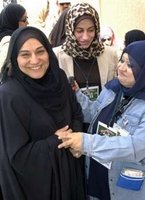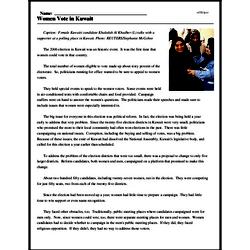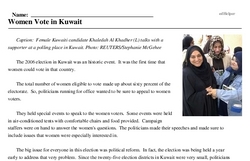Women Vote in Kuwait
Caption: Female Kuwaiti candidate Khaledah Al Khadher (L) talks with a supporter at a polling place in Kuwait. Photo: REUTERS/Stephanie McGehee
The 2006 election in Kuwait was an historic event. It was the first time that women could vote in that country.
The total number of women eligible to vote made up about sixty percent of the electorate. So, politicians running for office wanted to be sure to appeal to women voters.
They held special events to speak to the women voters. Some events were held in air-conditioned tents with comfortable chairs and food provided. Campaign staffers were on hand to answer the women's questions. The politicians made their speeches and made sure to include issues that women were especially interested in.
The big issue for everyone in this election was political reform. In fact, the election was being held a year early to address that very problem. Since the twenty-five election districts in Kuwait were very small, politicians who promised the most to their local community had often won elections in the past. There was little campaigning on national issues. Corruption, including the buying and selling of votes, was a big problem. Because of these issues, the emir of Kuwait had dissolved the National Assembly, Kuwait's legislative body, and called for this election a year earlier than scheduled.
To address the problem of the election districts that were too small, there was a proposal to change to only five larger districts. Reform candidates, both women and men, campaigned on a platform that promised to make this change.
About two hundred fifty candidates, including twenty-seven women, ran in the election. They were competing for just fifty seats, two from each of the twenty-five districts.
Since the election had been moved up a year, women had little time to prepare a campaign. They had little time to win support or even name recognition.
They faced other obstacles, too. Traditionally, public meeting places where candidates campaigned were for men only. Now, since women could vote, too, there were separate meeting places for men and women. Women candidates had to decide whether to campaign in the men's public meeting places. If they did, they faced religious opposition. If they didn't, they had no way to address those voters.




